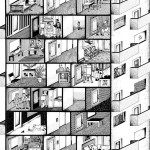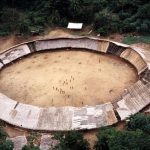
Cell 5 (Frankfurt)
The inhabitation cells (“Cellules d’habitation“) are six living pods for a single person designed by Israeli-born artist Absalon. After leaving his home country in the late 1980s, the artist joined Paris where he started a (sadly) short but intense career as a sculptor. The “cellules” are his last and most famous work: conceived for himself, each one was to be placed in a public space of a different city (Paris, Tokyo, New York, Tel Aviv, Zurich, and Frankfurt). The minimal living units were thought to let the artist embrace a nomadic lifestyle and at the same time an ascetic and isolated existence, protected from an oppressive society.

The cells, with a surface ranging from 4 to 9 m², were supposed to be realized as fully functioning habitats equipped with electricity and running water, but during his life Absalon was able to complete only one of them, whereas the other ones were built only as 1:1 wooden prototypes, painted in white on the inside and the outside. The research for the shape of each unit was conducted through an obsessive production of models in several scales and materials as well as with detailed drawings. The geometries of the cells and their serial nature echo both different movements and artists, (from minimalism to Allan McCollum’s investigations on mass production), and architectural researches in language and space from modernism to Russian constructivism. The cells show equally a strong synthesis between far away references and a profound personal reinvention, as Absalon’s work stands outside the boundaries of any movement or discipline.
Whereas the exterior geometry of each cell responds to its specific location, proportions and measures of the interiors are decided according to the artist’s own body, but not only to that. The minimum habitat is organized to fulfill Absalon’s exigence both in terms of “standard” daily living (there’s a kitchenette, a mattress, a workspace, a washroom and a toilet) and of his personal mental needs for hiding, contemplating, challenging himself and his habits. The notion of comfort is questioned because in the narrow space each act demands specific efforts to be performed. Bending, stretching, climbing is required in order to “use” the cell: to inhabit becomes a problematic action, not a mundane activity. The complex geometries ultimately reflect a mental space, the artist’s tension and his interior research.
The Cell is a mechanism that conditions my movements. With time and habit, this mechanism will become my comfort … The project’s necessity springs from the constraints imposed … by an aesthetic universe wherein things are standardized, average … I would like to make these Cells my homes, where I define my sensations, cultivate my behaviours. These homes will be a means of resistance to a society that keeps me from becoming what I must become. (Absalon, Cellules, 1993)
Only Cell n.1, the one for Paris, was built in its fully functional form, just before the artist’s death for AIDS in 1993. As Francesco Garutti observed in an article for Inventario #03, the legacy of Absalon lies in his ability to foresee, already in the early nineties, our era of security paranoia and constant control. Against the exposure of our private sphere on the new media and the conformity of our private space, the artists envisaged a “space of resistance”.

Cell 1 (Paris)

Cell 2 (Zurich)

Cell 3 (New York)

Cell 6 (Tokyo)






© The estate of Absalon





[…] Images of Absalon’s Cellules exhibited at KW Institute for Contemporary Art, Berlin in 2010. Source: socks-studio.com […]